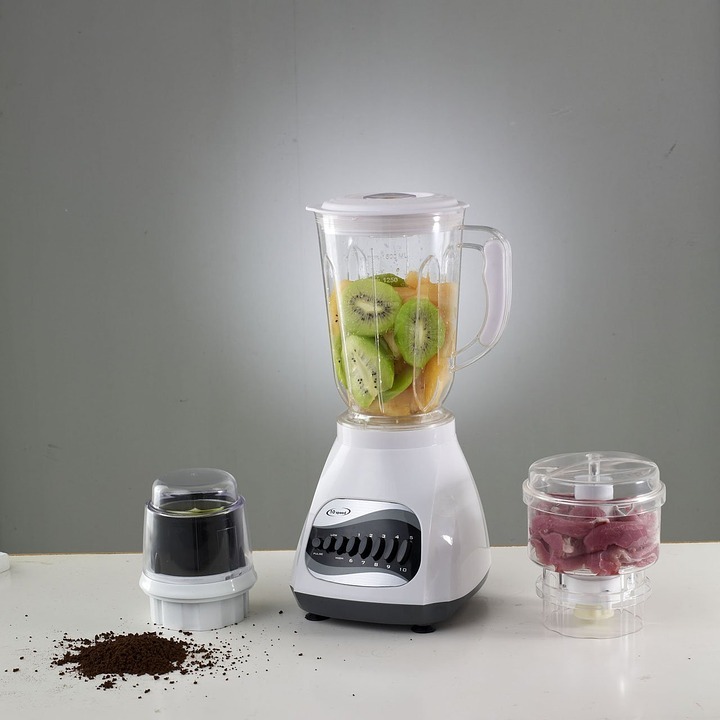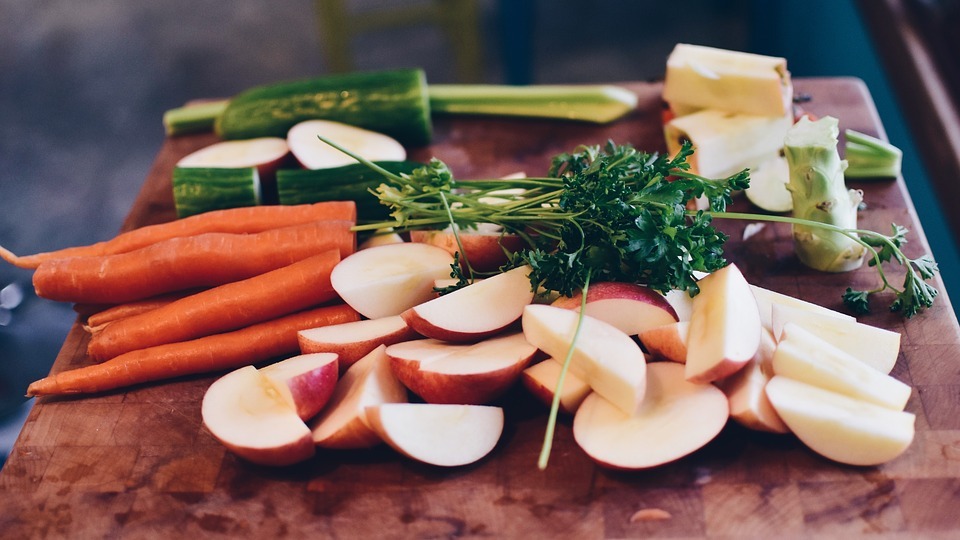Purslane Juice: A Mild, Omega-3-Rich Green for Juicing
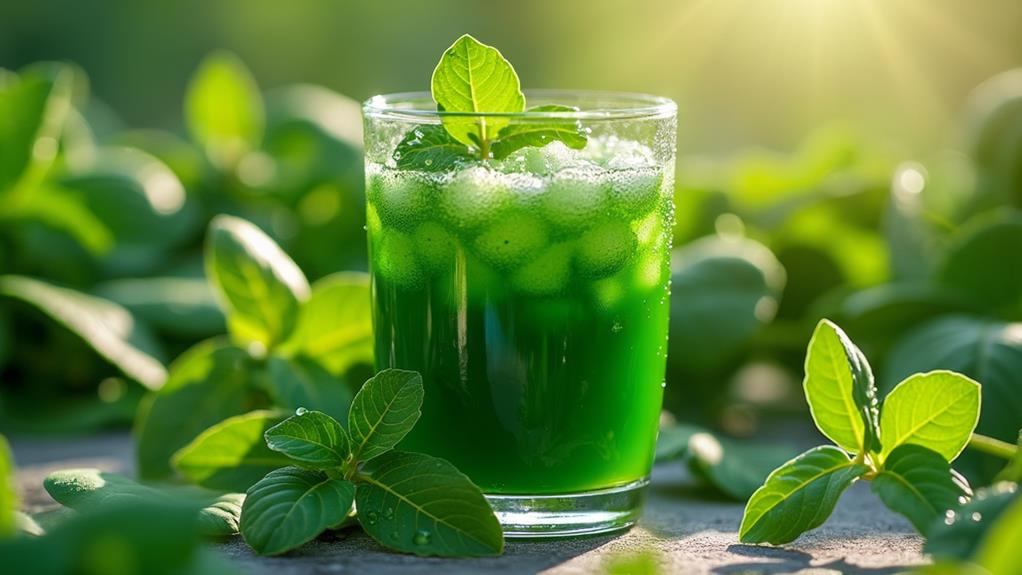
Adding purslane juice to your diet offers a mild flavor with rich omega-3 benefits. This leafy green packs 300-400 mg of alpha-linolenic acid per 100g, making it a star among plant-based sources. It's low in calories but high in potassium, magnesium, and vitamin C, providing a nutrient-dense enhancement to your juices. Besides omega-3s, purslane's antioxidants can help protect against oxidative stress. The plant's modest, tangy taste pairs well with other greens like spinach or kale, enriching your drink's nutritional profile. Investigate further to uncover how purslane can complement different culinary creations and enhance your everyday meals.
Understanding Purslane's Botanical Traits
Recognizing purslane's unique botanical traits can deepen your appreciation for this resilient plant. Purslane, or Portulaca oleracea, stands out among leafy green vegetables with its fleshy, annual succulent nature. It can grow up to 30 cm high, and you'll find its cylindrical, smooth stems supporting small, green or occasionally red-tinged leaves. What really sets purslane apart is its ability to thrive in poor soils and drought conditions, thanks to its unique form of photosynthesis. This process allows the plant to capture carbon dioxide at night, making it a rich source of resilience and adaptability.
Purslane's small flowers bloom on sunny days from May to September, leading to the production of seed capsules that guarantee its propagation and survival. Although often considered a weed, it's widely accepted as a potherb in regions like Europe, Asia, and the Mediterranean, showcasing its versatility. The scientific name "Portulaca" comes from the Latin term for a "milk-bearing cultivated plant," underscoring its historical significance and long-standing presence in traditional diets. By understanding these botanical traits, you can truly appreciate the health benefits and culinary potential purslane offers as a leafy green vegetable.
Nutritional Benefits of Purslane
In conjunction with its botanical resilience, purslane offers a variety of nutritional benefits that make it a standout choice for your diet. Purslane is an exceptionally rich source of omega-3 fatty acids, boasting 300-400 mg of alpha-linolenic acid (ALA) per 100g serving. This content surpasses many other vegetables, providing heart and brain health support. Alongside its omega-3s, purslane is packed with vitamin C, offering approximately 35% of your daily value per 100g serving. This vitamin is fundamental for immune function and skin health.
Moreover, purslane is loaded with significant minerals, including 494 mg of potassium, 68 mg of magnesium, and 65 mg of calcium per 100g. These minerals are critical for bone health and metabolic processes, ensuring your body's systems function efficiently. The plant's antioxidant content, such as glutathione and melatonin, helps protect your cells from oxidative stress, promoting comprehensive well-being.
With its unique nutritional profile, purslane stands out as one of the most nutritious leafy greens available. Adding it to your juices or meals not only improves flavor but also enriches your diet with important nutrients, making it a wise choice for a healthier lifestyle.
Purslane's Omega-3 Richness
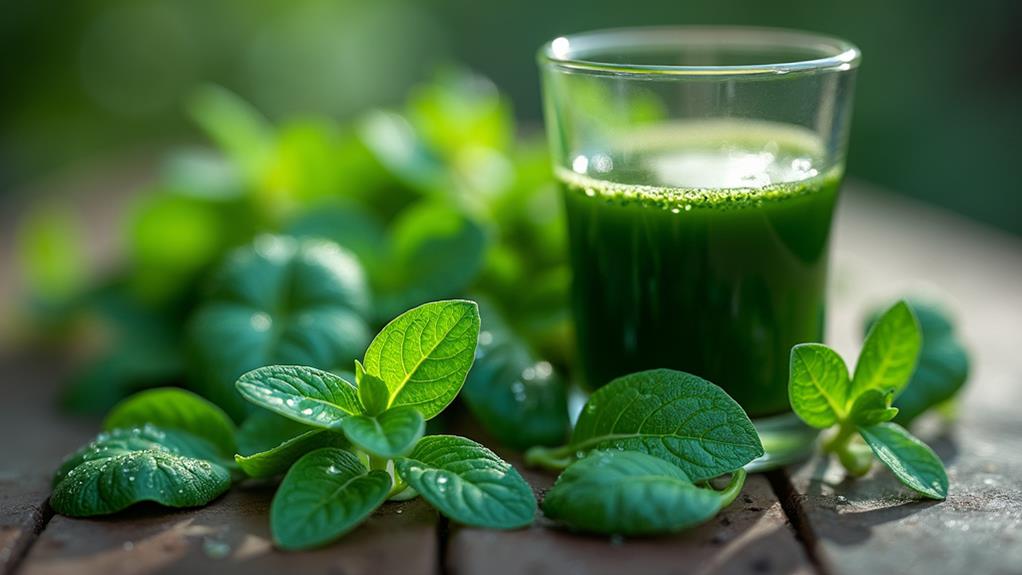
Purslane stands out not only for its thorough nutritional profile but particularly for its remarkable omega-3 content. Purslane contains one of the highest concentrations of omega-3 fatty acids among leafy greens, making it an excellent source for those seeking plant-based nutrients. With approximately 300-400 mg of alpha-linolenic acid (ALA) per 100g serving, it surpasses many other vegetables, boasting an omega-3 content of 0.9 g per 100g. This makes purslane a powerhouse for supporting heart health, as omega-3 fatty acids are known to help reduce the risk of heart disease.
You might be surprised to learn that purslane contains 5-7 times more ALA than spinach, highlighting its superiority in the domain of leafy greens. Since ALA is a crucial fatty acid that the body can't produce, incorporating purslane into your diet provides a valuable plant-based source of this nutrient. Moreover, purslane offers trace amounts of EPA, a more biologically active omega-3, contributing to chronic disease prevention.
Besides its omega-3 richness, purslane is also rich in vitamins, enhancing its overall nutritional appeal. Including purslane in your juicing routine can be a delicious way to elevate your omega-3 intake and support general wellness.
Antioxidant Properties of Purslane
Loaded with antioxidants, purslane offers a formidable defense against oxidative stress and cellular damage. You'll find that purslane is loaded with Vitamin C, E, and beta-carotene, all vital in protecting your cells from harm. These antioxidant properties work tirelessly to reduce the risk of chronic diseases by neutralizing free radicals that can cause cellular damage. Purslane's high levels of glutathione and melatonin further support cellular protection and even contribute to better sleep quality.
In addition to these benefits, purslane contains betalains, which have been shown to shield LDL cholesterol from oxidative damage. This means that incorporating purslane into your diet could enhance your cardiovascular health. The plant's total phenolic content, ranging from 127-478 mg GAE/100g, highlights its strong antioxidant potential. These vitamins and minerals are essential in fighting off oxidative stress, providing a natural armor for your body.
Moreover, purslane exhibits an impressive DPPH scavenging capacity (IC50) between 0.89-3.41 mg/mL, demonstrating its effectiveness in neutralizing free radicals. By consuming purslane, you're making a proactive choice to elevate your body's defenses, thanks to its rich antioxidant properties.
Health Advantages of Purslane
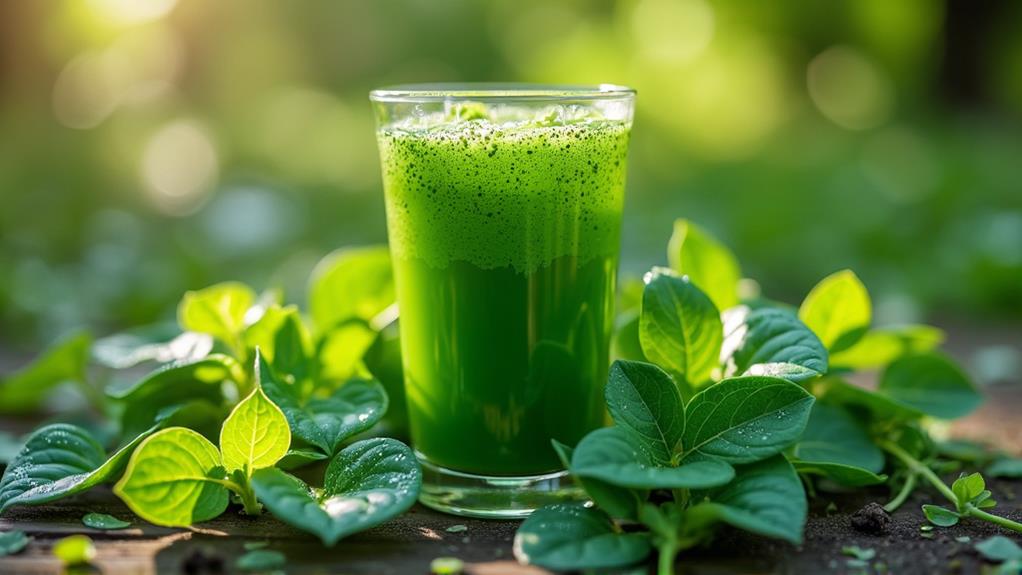
While purslane's antioxidant properties offer a powerful shield for your cells, its health advantages extend far beyond just cellular protection. As an exceptionally rich source of omega-3 fatty acids, particularly alpha-linolenic acid (ALA), purslane supports cardiovascular health. Consuming around 300-400 mg per 100g serving can help lower cholesterol and triglyceride levels, protecting your heart.
Purslane is also a powerhouse of vitamins, with 35% of your daily value of vitamin C per 100g. This not only enhances your immune function but also contributes to skin health and vision improvement. The high antioxidant properties in purslane, attributed to its vitamins C and E, along with betalains, play a vital role in reducing inflammation and potentially lowering cancer risk.
In addition to these benefits, purslane offers important minerals like potassium and magnesium, with 494 mg and 68 mg per 100g, respectively. These nutrients support heart health, assist in metabolic processes, and help regulate blood pressure. With only 16 kcal per 100g, purslane allows you to enrich your diet without adding excessive calories. It's a nutrient-dense choice that supports comprehensive well-being, making it a brilliant enhancement to your juice regimen.
Culinary Uses of Purslane
In the culinary world, purslane stands out as a versatile and nutritious ingredient. You can enjoy it raw in salads, where it adds a unique flavor and texture reminiscent of spinach and watercress. Its slightly sour or salty taste makes it a delightful enhancement. Purslane shines in juices, enhancing the drink's health benefits with its rich source of omega-3 fatty acids and antioxidants. This green not only elevates nutrients but also gives your juice a revitalizing twist.
If you're cooking, purslane fits perfectly into a variety of dishes. Its distinctive taste complements:
- Soups, enhancing both flavor and nutrition
- Omelets, adding a healthy twist to breakfast
- Herb blends, pairing well with cilantro and parsley
- Mediterranean and Asian cuisines, where it's traditionally used for its health benefits
Purslane's culinary uses are indeed vast, and it seamlessly integrates into your kitchen repertoire. Regardless of being raw or cooked, its omega-3 fatty acid content and unique flavor make it a standout ingredient. You'll find it easy to incorporate purslane into your meals, enjoying both its taste and the myriad health benefits it offers.
Historical and Cultural Significance

Purslane, known scientifically as Portulaca oleracea, holds a rich historical and cultural significance that spans continents and centuries. This plant's roots trace back to the Middle East and India, where it thrived as a valuable resource. Ancient Greek texts from the 4th century BC document its use in both kitchens and medicine, underscoring its long-standing importance. Theophrastus, an ancient Greek philosopher, even noted April as the best time to plant purslane, highlighting its agricultural role.
Purslane's expedition didn't stop in the Middle East and Greece; it spread globally and reached North America before Columbus's time, potentially through Viking or Asian migrations. Its seeds were a staple in Australian aboriginal diets, and Greeks transformed its seed flour into bread, exemplifying its versatility.
The etymology of "purslane" links to the Latin term for sow, reflecting its use in treating uterine issues, which showcases its medicinal significance. With its high omega-3 content, purslane has been cherished as a nutritious, medicinal plant. Across cultures, its adaptability and nutrient richness have made it a valued component in both ancient and modern diets.
Tips for Growing Purslane
With its rich historical and cultural significance, you're probably enthusiastic to grow purslane in your own garden. This resilient plant is not only easy to cultivate but also packed with nutrients. Purslane thrives in poor, dry soils, making it a perfect choice if you're looking for a low-maintenance supplement to your edible landscape.
To guarantee successful growth, keep these tips in mind:
- Timing is key: Plant purslane seeds in April to take advantage of the warmer months. This timing aligns with advice from ancient botanist Theophrastus.
- Maximize sunlight: Purslane loves full sun exposure, so choose a sunny spot in your garden or even exploit the cracks in your sidewalk.
- Encourage continuous growth: Regularly harvest the young stems and leaves. Doing so not only provides you with fresh greens but also stimulates further growth, keeping the plant nutrient-rich.
- Propagate easily: Once established, purslane produces seeds in capsules, guaranteeing a steady supply. You can let them reseed naturally or collect them for controlled planting.
Incorporating Purslane in Juices
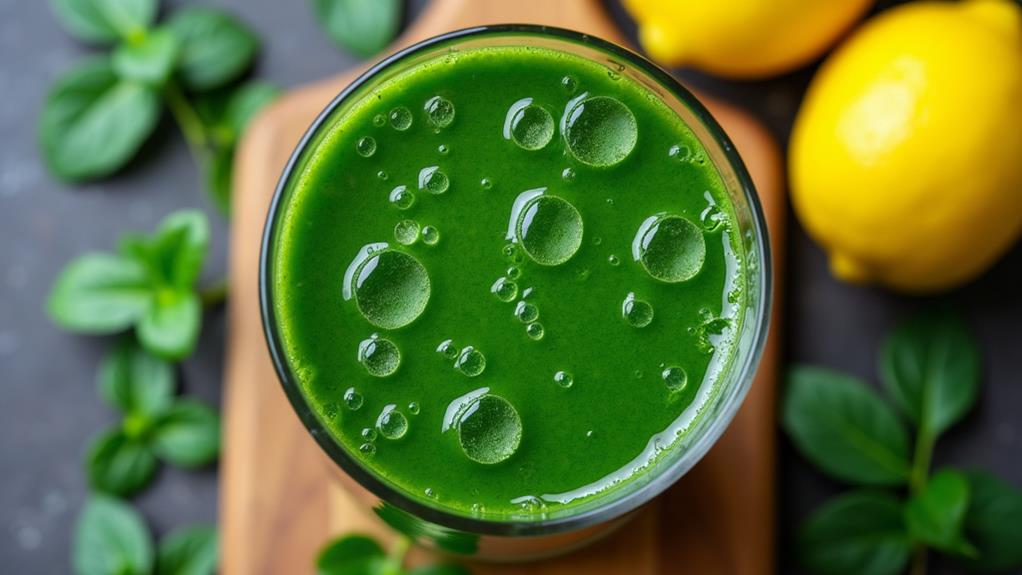
A handful of purslane leaves can transform your juice into a nutrient powerhouse. As a leafy vegetable, purslane stands out with its impressive profile. It's one of the richest plant sources of omega-3 fatty acids, delivering about 300-400 mg per 100g serving. These vital fats are important for heart and brain health. To enjoy its benefits, simply blend fresh purslane leaves with water. The mildly sour flavor easily complements other ingredients, making it a versatile supplement to your juicing routine.
Purslane's high vitamin C content, approximately 35% of the daily value per 100g, improves your juice by supporting your immune system and promoting skin health. This leafy green is also packed with antioxidants like glutathione and melatonin, which help combat oxidative stress and protect your cells from damage. By incorporating purslane, you elevate the antioxidant capacity of your juice, giving you an extra layer of health protection.
For a flavorful and nutrient-dense drink, consider mixing purslane with other leafy greens like spinach or kale. This combination not only improves the taste but also optimizes the intake of vital nutrients and omega-3s, making your juice a true health elixir.

